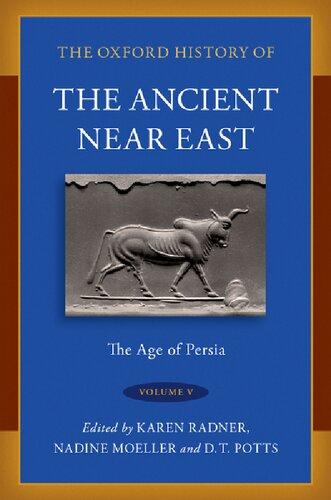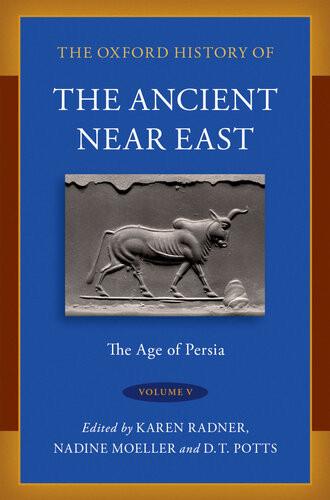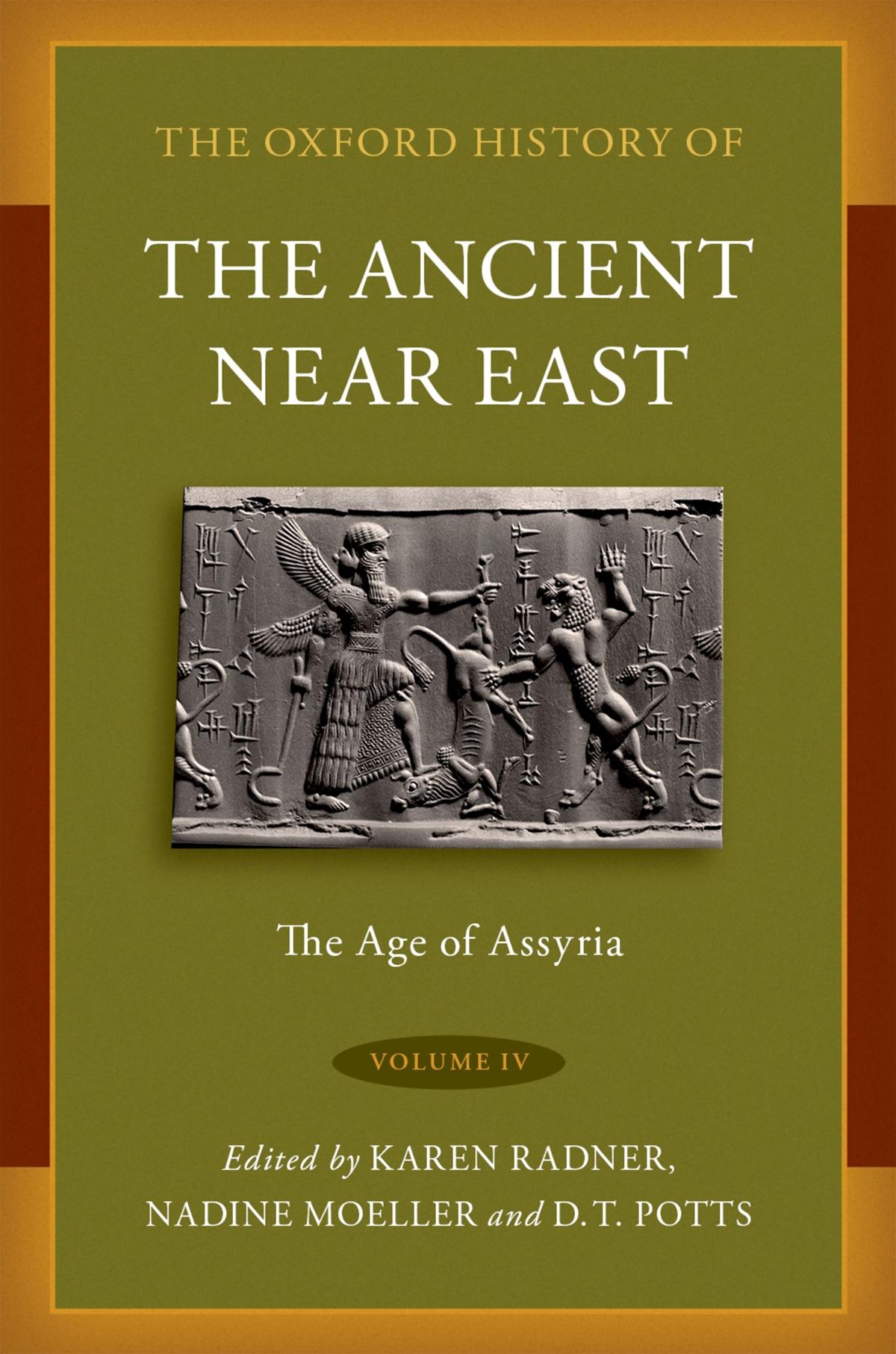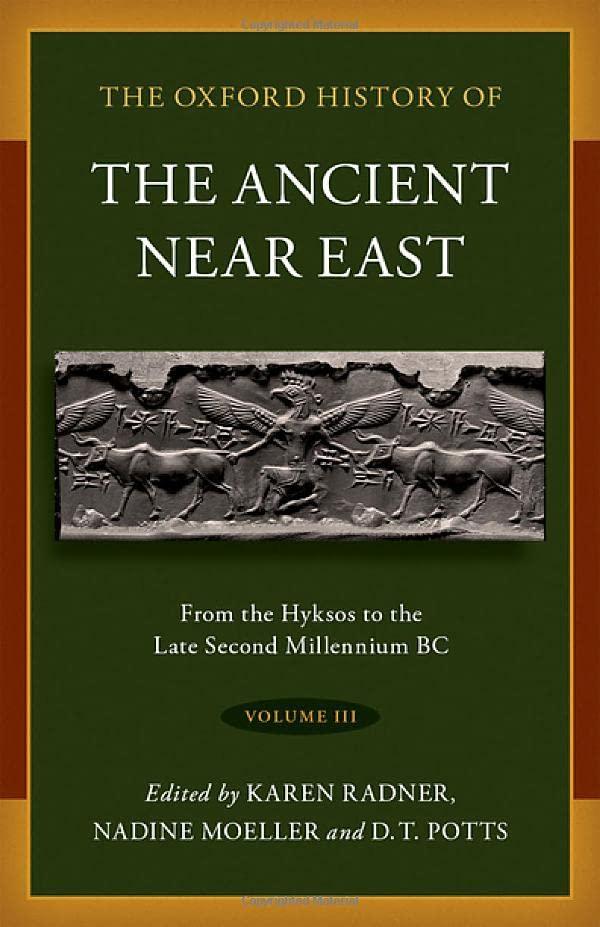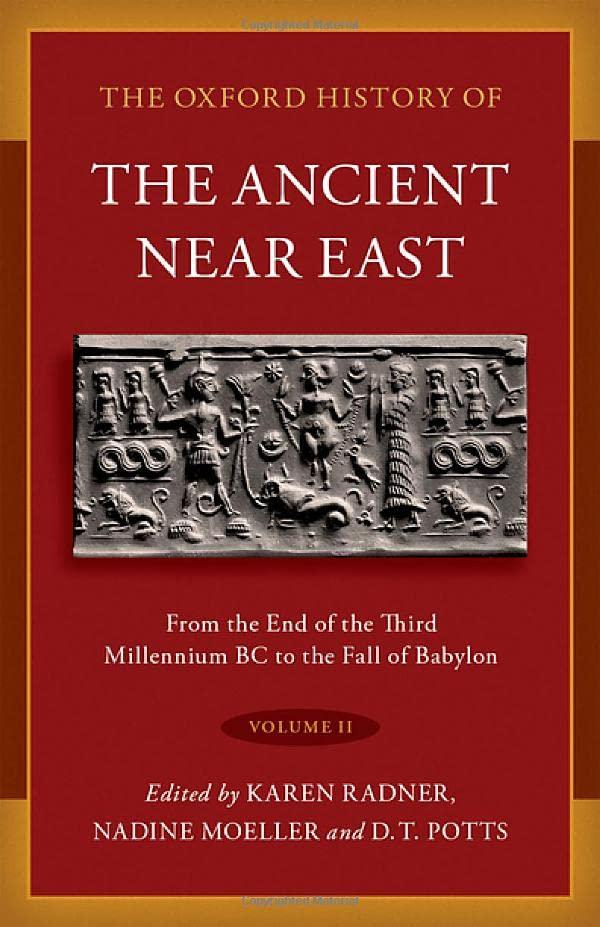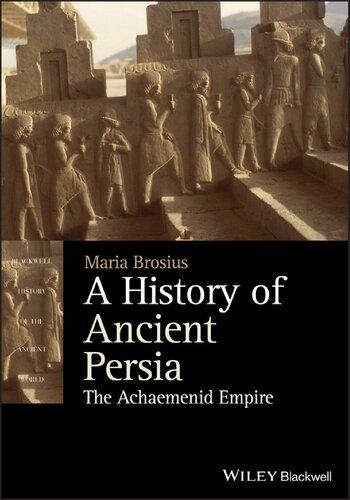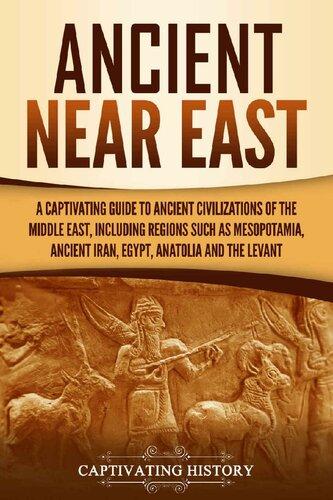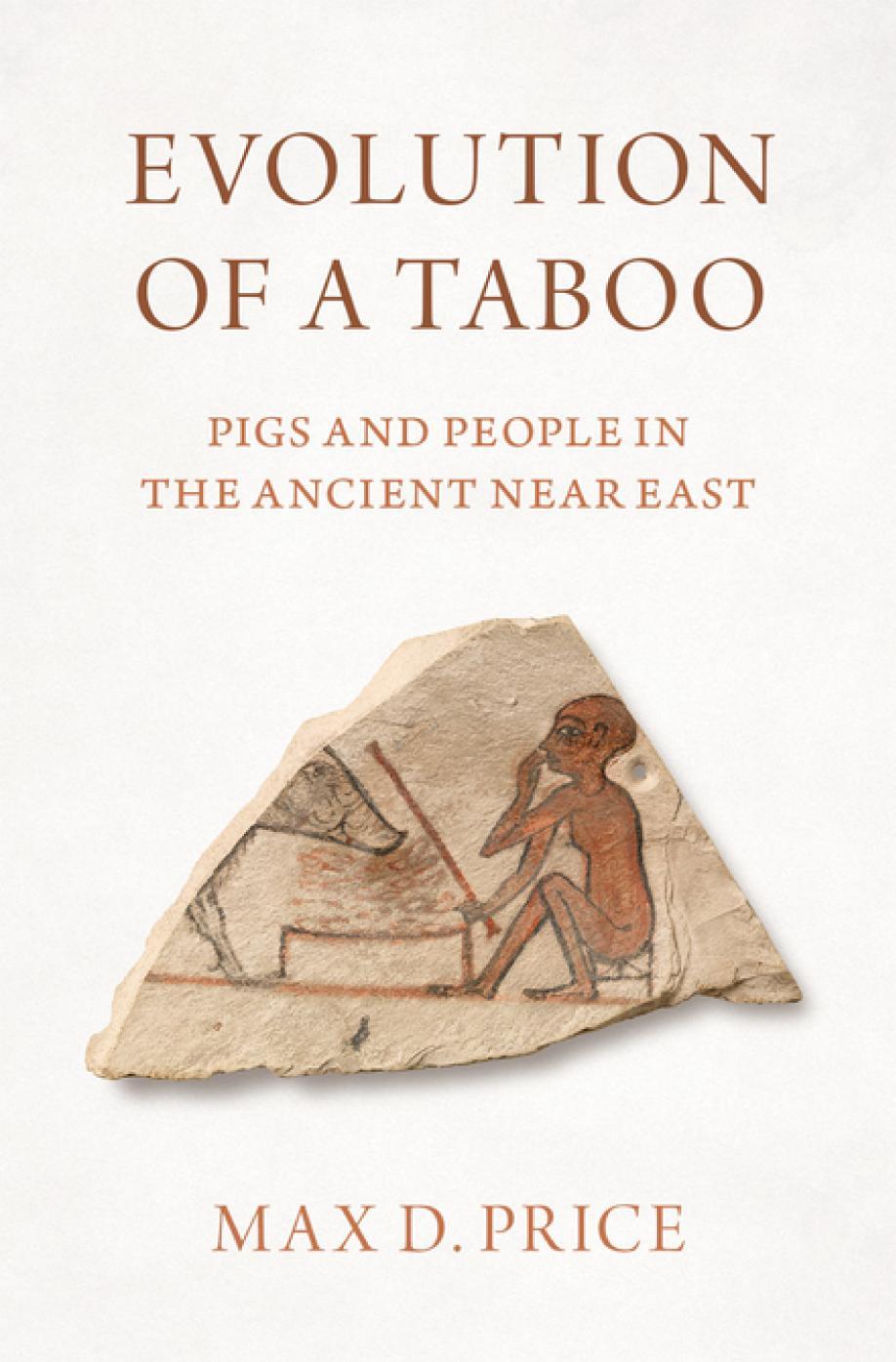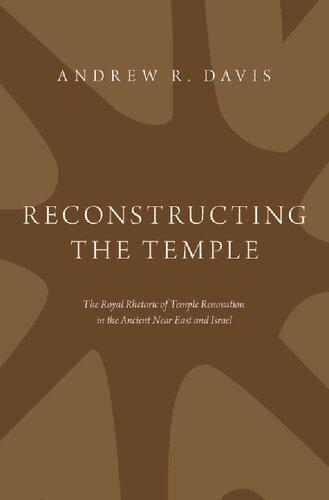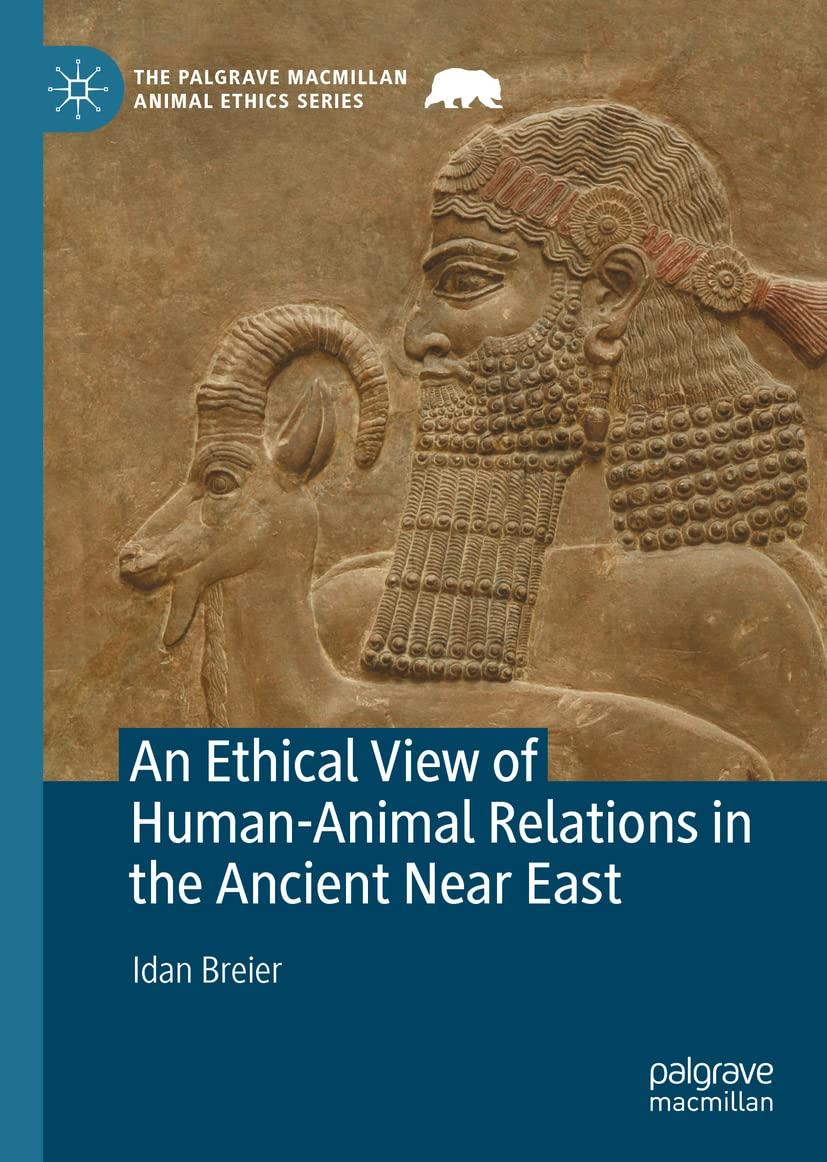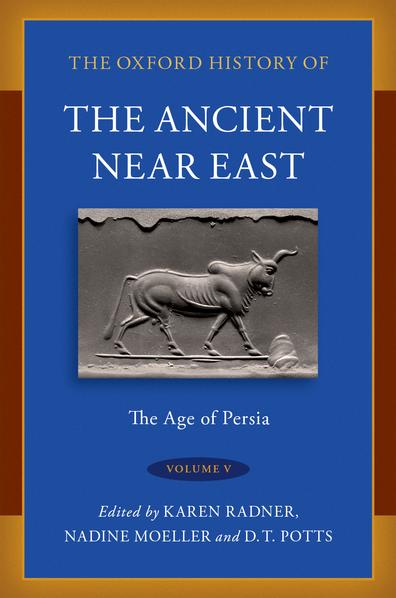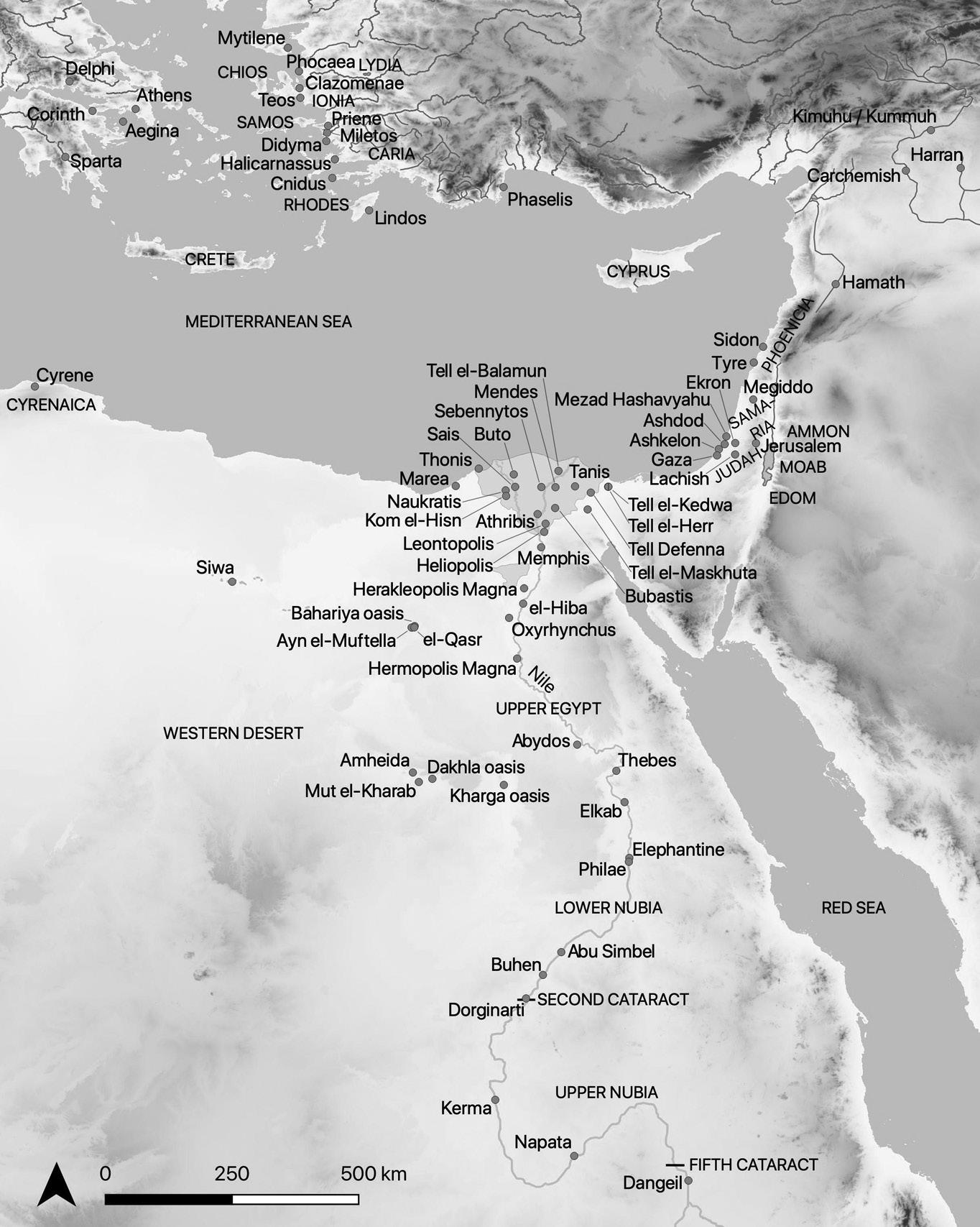The Oxford History of the Ancient Near East
Volume V: The Age of Persia
z
Edited by KAREN RADNER
NADINE MOELLER D. T. POTTS
Oxford University Press is a department of the University of Oxford. It furthers the University’s objective of excellence in research, scholarship, and education by publishing worldwide. Oxford is a registered trade mark of Oxford University Press in the UK and certain other countries.
Published in the United States of America by Oxford University Press 198 Madison Avenue, New York, NY 10016, United States of America.
© Oxford University Press 2023
All rights reserved. No part of this publication may be reproduced, stored in a retrieval system, or transmitted, in any form or by any means, without the prior permission in writing of Oxford University Press, or as expressly permitted by law, by license, or under terms agreed with the appropriate reproduction rights organization. Inquiries concerning reproduction outside the scope of the above should be sent to the Rights Department, Oxford University Press, at the address above.
You must not circulate this work in any other form and you must impose this same condition on any acquirer.
CIP data is on file at the Library of Congress
ISBN 978–0–19–068766–3
DOI: 10.1093/oso/9780190687663.001.0001
Printed by Sheridan Books, Inc., United States of America
49. Saite Egypt (Alexander Schütze) 1
50. The Neo-Babylonian Empire (Michael Jursa) 91
51. The Kingdom of Lydia (Annick Payne) 174
52. The Southern Levant and Northern Arabia in the Iron Age (Juan Manuel Tebes) 231
53. Early Saba and Its Neighbors (Norbert Nebes) 299
54. The Persian Empire under the Teispid Dynasty: Emergence and Conquest (Matt Waters) 376
55. The Persian Empire under the Achaemenid Dynasty, from Darius I to Darius III (D. T. Potts) 417
56. The Satrapies of the Persian Empire: Persia and Elam (Gian Pietro Basello) 521
57. The Satrapies of the Persian Empire: Media and Armenia (Giusto Traina) 556
58. The Satrapies of the Persian Empire in Asia Minor: Lydia, Caria, Lycia, Phrygia, and Cappadocia (Hilmar Klinkott) 592
59. The Satrapies of the Persian Empire: Babylonia and Assyria (André Heller) 649
60. The Satrapies of the Persian Empire: Ebir-nari/Syria (Peter R. Bedford) 689
61. The Satrapies of the Persian Empire in Egypt (Damien Agut-Labordère) 737
62. The Northeastern Regions of the Persian Empire: Bactriana, Sogdiana, Margiana, Chorasmia, Aria, Parthia, the Sakas, and the Dahae (Michele Minardi) 784
63. The Southeastern Regions of the Persian Empire on the Indo-Iranian Frontier: Arachosia, Drangiana, Gedrosia, Sattagydia, Gandhara, and India (Pierfrancesco Callieri) 837
64. The Persian Empire in Contact with the World (Robert Rollinger) 887
65. The Persian Empire: Perspectives on Culture and Society (Maria Brosius) 949
Preface
The fifth and final volume of the Oxford History of the Ancient Near East deals with the Persian Empire and its immediate predecessor states: Saite Egypt, the Neo-Babylonian Empire, and the kingdom of Lydia, as well as the kingdoms, chiefdoms, and tribal alliances shaping the political geography of the southern Levant and northern and southern Arabia, the roots of many of which go back to times covered by the previous volumes in this series. The areas covered include Egypt, Nubia and Ethiopia, the Caucasus, Anatolia and the Aegean, the Levant and the Arabian Peninsula, Mesopotamia and Iran, and for the first time in the series, Central Asia and the Indo-Iranian borderlands in what are today Afghanistan and Pakistan. The chronological scope of the volume extends from the second half of the seventh century bc until the campaigns of Alexander III of Macedon (336–323 bc) brought an end to the Achaemenid Dynasty and the Persian Empire.
This book’s cover depicts the fifth and final specimen in our collection of beautiful cylinder seals selected from different parts of the Near East to grace the individual covers of the Oxford History of the Ancient Near East. The brown chalcedony seal from the collection of the Morgan Library & Museum, New York (accession number 0837) shows a solitary, striding zebu bull (Bos indicus). Acquired by Pierpont Morgan between 1885 and 1908, the seal shows an animal most often associated with South Asia, where the easternmost provinces of the Persian Empire were located. By the fifth century bc, however, when this seal was probably manufactured, the zebu was found across the Near East, and was thus no longer unfamiliar or exotic to the peoples of the region.
The fourth volume of the Oxford History of the Ancient Near East closes with the collapse of the Assyrian Empire and some of its contemporary states, including the kingdom of Phrygia in central Anatolia and the kingdom of Mannea in northwestern Iran, and the formation of its successor states, most importantly the Median kingdom, the kingdom of Lydia, the Neo-Babylonian Empire, and a reunited and independent Egyptian state under the Saite Dynasty (in Manetho’s sequence, the Twenty-sixth Dynasty). While the short-lived and poorly documented Median kingdom is covered in the fourth volume (chapter 43) as a coda to the discussion of the history of the Median chiefdoms in the shadow of the Assyrian Empire, the present volume starts with chapters dedicated to the other three states that contributed to and/or benefited from the end of that empire. They are joined by a chapter on the kingdom of Saba centered on what is today Yemen and a chapter on the tribes and chiefdoms of the southern Levant and northern Arabia that successfully carved an existence out of the harsh desert environment and made an essential contribution to the long- distance trade and communication network that linked the Mediterranean coast, the southern regions of the Arabian Peninsula, and southern Mesopotamia. Whereas the chapters on Saite Egypt and the Neo-Babylonian Empire draw on a wealth of locally produced textual sources in the traditional writing systems of the core regions, those on Lydia and the desert- dwelling polities rely to a much greater extent on archaeological information, and frequently also on much more recent texts. In the case of Lydia this means the works of classical writers, and for the southern Levant and northern Arabia, the Bible. On occasion, the alphabetic scripts used in these areas were used for monumental inscriptions on durable materials (see figure 51.4 for an example of a Lydian inscription and figure 53.3 for a South Arabian example) but most of the written documentation was recorded on organic surfaces and materials that have not survived. As a consequence, these first chapters illustrate a wide range of approaches to history-writing as enabled, constrained, or demanded by the availability of sources and their respective challenges and advantages. Such drastically different approaches also characterize the group of twelve chapters dealing with the Persian Empire, which was created by
two members of the Teispid Dynasty: Cyrus II (the Great; 559–530 bc) and his son and successor Cambyses II (530–522 bc), and consolidated, after a succession conflict that brought the young state to the brink of collapse, by Darius I (the Great; 522–486 bc) and his descendants, who constituted the Achaemenid Dynasty. Two chapters are therefore dedicated to the two constituent dynasties of the Persian Empire. The next eight chapters have a regional focus. The first six of these deal with the core region of the Persian Empire (Parsa and Elam); the mountainous regions shaped by the Zagros and the Caucasus (Media and Armenia); Asia Minor (Lydia, Caria, Lycia, Phrygia, and Cappadocia); Mesopotamia (Babylonia and Assyria); Syria and the Levant (known as Ebir-nari, “Across-the-River,” referring to the Euphrates); and Egypt with Nubia and Libya. With the next two chapters, we enter areas that have not enjoyed prominence in any of the previous volumes of the Oxford History of the Ancient Near East: eastern Iran and Central Asia (Bactriana, Sogdiana, Margiana, Chorasmia, Aria, Parthia, and the steppe-dwelling Sakas and Dahae) and the Indo-Iranian borderlands (Arachosia, Drangiana, Gedrosia, Sattagydia, Gandhara, and Hinduš/“India”). Depending on the region, a diverse range of textual sources stand in the center of the narrative that engender very different approaches: from the careful consideration of a region’s climatic and geographical characteristics, to the study of various text genres recorded on stone, clay, papyrus, and wood (for an example, see figure 64.3), to the analysis of diverse expressions of material culture such as seals, coins, or pottery, to the interpretation of monumental, domestic, and funerary architecture. The final two chapters of the volume focus on the cultural and social history of the Persian Empire, on the one hand, and its interaction with the wider world, on the other hand, thus continuing a format already used in previous volumes for the most influential of the ancient Near Eastern states.
The following time chart presents a concise overview of the chronological coverage of this volume. The earlier parts of this chart may be consulted together with the time chart given in the fourth volume of the Oxford History of the Ancient Near East, as there is some chronological overlap.
Preface
Our editorial work on the Oxford History of the Ancient Near East was supported by the Center for Advanced Studies of LMU Munich (CASLMU), which awarded fellowships to Nadine Moeller and Dan Potts in July 2016, 2017, and 2018, and again in 2020 and 2021, although these could not be taken up because of the impact of the still ongoing COVID-19 (Sars- CoV-2) pandemic on travel and all forms of physical interaction. However, the weeks spent together in Munich in 2016–2018 enabled us to lay the groundwork that underpins this volume, in particular structuring the book and recruiting the scholars who would take on the individual chapters. Just as the previous volumes of the Oxford History of the Ancient Near East did, this book combines the talent and expertise of distinguished scholars from across the globe, each a recognized expert in their subject area, in order to offer new and often also complementary perspectives on the history of northeastern Africa, the eastern Mediterranean, the Middle East, and Central Asia from the seventh to the fourth century bc. We are fortunate that these scholars have made space in their busy schedules to contribute the seventeen chapters that constitute the present volume, covering “The Age of Persia.” Draft manuscripts for the chapters were received between May 2019 and August 2021. All of the joint editorial work on the chapters of this fifth volume had to be accomplished without the ability to meet and discuss issues in person. That the process was nevertheless productive and invariably smooth is owed to our joint GoogleDrive folders and our WhatsApp group, and to the trust and solid routines we have established in the five years since we started working on this large-scale publication project in 2016 at the behest of our friend and editor at Oxford University Press, Stefan Vranka.
In transcribing Egyptian proper nouns, we follow the conventions of The Oxford History of Ancient Egypt, edited by Ian Shaw (OUP 2004, rev. ed.). We do not use hyphenation to separate the components of Greek, Persian, and other Indo-European personal names, but we follow normal practice in marking the individual words within Akkadian proper nouns (e.g., Bel-uṣuršu; Nabû-tattannu-uṣur). Whenever a person or place is widely known by a conventional spelling, we use that (e.g., Nabopolassar instead of Nabû-aplu-uṣur, Nebuchadnezzar instead of Nabû-kudurrī-uṣur, Cutha instead of Kutiu). We do not use long
vowels in proper nouns, including modern Arabic and Farsi place names. The abbreviations used for classical authors and their works follow The Oxford Classical Dictionary, edited by Simon Hornblower, Antony Spawforth, and Esther Eidinow (OUP 2012, 4th ed.).
We are very grateful that the generous funding of the Alexander von Humboldt Foundation, granted in the form of the International Award for Research in Germany to Karen Radner in 2015–2020 and, since 2020, funds made available by LMU Munich, afforded us the help of several individuals whose expertise and attention to detail greatly facilitated the editing of this book. At LMU Munich, Denise Bolton carefully and cheerfully language-edited most of the chapters; Thomas Seidler checked and consolidated the chapter bibliographies, as well as standardized the references to classical authors; Philipp Seyr (now Liège) harmonized the Egyptian names and spelling; and Dr. Andrea Squitieri created the cartography for the individual chapters. The index was again expertly prepared by Luiza Osorio Guimarães da Silva (Chicago), who was also instrumental in harmonizing proper nouns across chapters and volumes. On this final volume and on all others before it, our editor Stefan Vranka supported our work at every step. To all of them, and also and especially to our authors, we owe heartfelt thanks for contributing to the realization of this book, despite the various challenges to our personal and professional lives that so many of us experienced especially in 2020 and 2021.
During the final stages of proof reading, Amélie Kuhrt died on January 3rd, 2023, aged 78 years. The doyenne of modern research on the Persian Empire and a pioneer in the comprehensive study of the ancient world from the Mediterranean to Central Asia, her work is referenced in almost all chapters of the present book. The five volumes of The Oxford History of the Ancient Near East survey the history of Egypt, the Levant, Anatolia, Mesopotamia, and Iran, and the neighboring regions, from the emergence of complex states to the conquests of Alexander the Great, and thus share the geographical and temporal scope of Amélie’s groundbreaking The Ancient Near East, c. 3000−330 BC (Routledge, 1995). As an analysis offered by a single scholar with an encyclopedic knowledge, a clear vision and a distinct voice, her work remains unsurpassed. A brilliant, generous and inspirational scholar and human being, Amélie is greatly missed.
Time Chart
Saba . . .
Assyria
Yi ṯ a‘’amar Watar
Sargon II (721–705)
Karib’il Watar
Cyaxares (624–585)
Gyges Ardys / Alyattes II
Sennacherib (704–681)
Esarhaddon (680–669)
Ashurbanipal (668–631)
Dynasty 26 (664–525)
700 BC
Nekau I (672–664)
Psamtek I (664–610)
Aššuretelilani (630–627)
Sadyattes
Astyages (585–549)
Alyattes III / Walwates
Nabopolassar (625–605)
Sînšarruiškun (626–612)
Aššuruballi ṭ II (611–609)
Nekau II (610–595)
Croesus
Nebuchadnezzar II (604–562)
Psamtek II (595–589)
600 BC
Apries (589–570)
Ahmose III / Amasis (570–526)
Mesopotamia
Anatolia / Aegean
Iran
South Arabia
Babylonia
Lydia Media
Persia
AmelMarduk (562–560) . . .
Cyrus II (559–530)
Neriglissar (560–556)
LabašiMarduk (556)
Nabonidus (555–539)
Cambyses II (529–522)
Bardiya / Smerdis (522)
Darius I (521–486)
Xerxes I (485–465)
Psamtek III (526–525)
Nebuchadnezzar III
Nebuchadnezzar IV
Artaxerxes I (464–424/ 423)
Petubastis IV
Psamtek IV
Inaros
Xerxes II (424/ 423) Sogdianus (424/ 423)
Darius II (423–405)
Cyrus the Younger
Artaxerxes II (404–359)
Dynasty 28 (404–399)
400 BC Amyrtaeus / Psamtek V (404–399)
Dynasty 29 (399 –380)
Nepherites I (399–393)
Achoris / Hakor (393–380)
Dynasty 30 (379 –343)
Nectanebo I / Nakhtnebef (379–361) Teos / Tachos / Djedhor (361–359)
Artaxerxes III (358–338)
Artaxerxes IV (337–336)
Darius III (335–330)
Macedon
Nectanebo II / Nakhthorheb (359–343)
Alexander III (336–323)
The Contributors
Damien Agut-Labordère is a permanent researcher at the Centre National de la Recherche Scientifique and a member of the Archéologies et Sciences de l’Antiquité (ArScAn) team based in Nanterre (France). Since 2017, he heads the Programme Achemenet ( http://www.acheme net.com/), a digital resource offering a wide range of tools, publications, and sources for the study of the Persian Empire. His research focuses on Persian Egypt and on the history of the Egyptian Western Desert in the first millennium bc. His numerous publications include Le sage et l’insensé: la composition et la transmission des sagesses démotiques (Champion, 2011); L’Égypte des pharaons: de Narmer à Dioclétien, 3150 av. J.-C.–284 apr. J.-C. (Belin, 2016; with Juan Carlos Moreno García); and Les vaisseaux du désert et des steppes: les camélidés dans l’Antiquité (Camelus dromedarius et Camelus bactrianus) (MOM éditions, 2020; with Bérangère Redon).
Gian Pietro Basello was appointed Associate Professor of Elamite Language at Università degli Studi di Napoli “L’Orientale” in 2020, after having taught there since 2010. Together with Javier Álvarez-Mon and Yasmina Wicks, he edited the volume The Elamite World (Routledge, 2018). Since 2003, he has participated in the Iranian–Italian joint project “Digital Achaemenid Royal Inscription Open Schema Hypertext” (DARIOSH). Beyond Elamite and Achaemenid studies, his research focuses on ancient calendars and systems for recording time.
Peter R. Bedford (PhD University of Chicago) is John and Jane Wold Professor of Religious Studies at Union College, New York. He has
published on the history and economy of imperial regimes in ancient Western Asia in the first millennium bc, and on Jewish history in the Achaemenid Persian period. His current research focuses on the political theology of imperial rule in ancient Western Asia and its effects on concepts of governance among subjugated peoples.
Maria Brosius was Associate Professor at the Department of Near and Middle Eastern Civilizations at the University of Toronto, from where she retired in 2019. Her research focuses on the history of preIslamic Persia, especially the Achaemenid period, as well as on the cultural, intellectual, and religious connections between Greece and the eastern Mediterranean. Her interest in the role of Persian women is reflected in many articles and especially her monograph Women in Ancient Persia (559–331 bc) (Oxford University Press, 1996, reprinted 2000, 2002). Further books include A history of ancient Persia: The Achaemenid Empire (Wiley-Blackwell, 2021); The Persians: an introduction (Routledge 2006); and the edited volume Ancient archives and archival traditions: concepts of record-keeping in the ancient world (Oxford University Press, 2003).
Pierfrancesco Callieri is Professor of the Archaeology of Ancient Iran at the Department of Cultural Heritage of the University of Bologna’s Ravenna Campus. His work concerns Iran and the Indo-Iranian borderlands in the historic, pre-Islamic periods, with a particular focus on these regions’ seals and ceramics. After taking up fieldwork in Pakistan in 1977 with the Italian Archaeological Mission in the Swat (Istituto italiano per il Medio ed Estremo Oriente), he initiated in 1984 the excavations at Barikot, now acknowledged as an archaeological key site for the northwest of the Indo-Pakistan subcontinent. Since 2005, when he was invited by Iran’s Cultural Heritage Handicrafts and Tourism Organization to undertake fieldwork in the Fars province, he has served as the Italian co-director of the Iranian-Italian Joint Archaeological Mission in Fars (University of Bologna and IsMEO) whose main activities concern the Achaemenid period, most importantly with the excavation of the gate complex of Tol-e Ajori near Persepolis.
André Heller (PhD University of Erlangen-Nürnberg 2010, Habilitation University of Bamberg 2020) is a Lecturer at the Julius-MaximiliansUniversität at Würzburg. The author of Das Babylonien der Spätzeit (7.–4. Jh.) in den klassischen und keilschriftlichen Quellen (Verlag Antike, 2010), a study comparing the image of Babylonia in the Greco-Roman sources with the cuneiform tradition, his research focuses on the Ancient Near East in the first millennium bc and its cultural exchange with the Greek world, the Hellenistic kingdoms (especially the Seleucids), and the history of the Roman Empire.
Michael Jursa is Professor of Assyriology at the University of Vienna and a member of the Austrian Academy of Sciences. His principal research interest is Babylonian socioeconomic history. His numerous publications include Neo-Babylonian legal and administrative documents: typology, contents and archives (Ugarit-Verlag, 2005); Aspects of the economic history of Babylonia in the first millennium BC: economic geography, economic mentalities, agriculture, the use of money and the problem of economic growth (Ugarit-Verlag, 2010); and Letters and documents from the Eanna Archive (Yale University Press, 2011).
Hilmar Klinkott (PhD University of Tübingen) is Professor of Ancient History at the Christian Albrechts University at Kiel. His research focuses on Greek and Ancient Near Eastern history, and he has published monographs on the administration and history of the Persian Empire (Der Satrap: ein achaimenidischer Amtsträger und seine Handlungsspielräume, Verlag Antike, 2005), as well as of Alexander the Great and the Hellenistic monarchies (Die Satrapienverwaltung der Alexander- und Diadochenzeit, Franz Steiner, 2000).
Michele Minardi (PhD University of Sydney) is Assistant Professor of Iranian Archaeology at the University of Naples “L’Orientale”. He is Field Director of the Karakalpak-Australian Expedition to Ancient Chorasmia (since 2010) and of the IsMEO / Ca’ Foscari Italian Archaeological Mission in Pakistan (since 2020). As a grantee of the White-Levy Program for Archaeological Publications, he is currently working on an archaeological reappraisal of Old Kandahar, based on
unpublished data from the British excavations conducted from 1976 to 1978.
Nadine Moeller (PhD University of Cambridge) is Professor of Egyptian Archaeology at Yale University. Her research focuses on ancient Egyptian urbanism, on which she has published the monograph The archaeology of urbanism in ancient Egypt (Cambridge University Press, 2016). She has participated in numerous fieldwork projects in Egypt and since 2001, she has been directing excavations at Tell Edfu in southern Egypt.
Norbert Nebes (PhD LMU Munich), recently retired Professor of Semitic Philology and Islamic Studies, is Head of the Research Center Ancient South Arabia and Northeast Africa at the Friedrich Schiller University of Jena. His main areas of research are Classical and Ancient South Arabic. Working on the language, society, and culture of preIslamic South Arabia, he has regularly been involved as an epigraphist in the excavations and expeditions of the German Archaeological Institute in Yemen and Ethiopia. His recent publications, such as Der Tatenbericht des Yiṯa‘’amar Watar bin Yakrubmalik aus Ṣirwāḥ (Wasmuth, 2016), deal with the political history of South Arabia in the early first millennium bc, as well as the immigration of Sabean populations to the northern Horn of Africa.
Annick Payne is a Lecturer in Ancient Near Eastern languages at the University of Bern as well as an associated researcher of its Center for Global Studies. Her research focuses on Anatolian languages and writing systems, especially Anatolian hieroglyphic and alphabetic writing. She is the epigrapher of the excavations at Sirkeli Höyük and AdanaTepebağ. Her books include Hieroglyphic Luwian texts in translation (SBL Press, 2012); Hieroglyphic Luwian: an introduction with original texts (Harrassowitz, 2014); and Schrift und Schriftlichkeit: die anatolische Hieroglyphenschrift (Harrassowitz, 2015).
Daniel T. Potts (PhD Harvard University) is Professor of Ancient Near Eastern Archaeology and History at the Institute for the Study of the Ancient World, New York University. A Corresponding Member of the German Archaeological Institute, he has worked in Iran, the
United Arab Emirates, Saudi Arabia, Turkey, Armenia, and the Kurdish Autonomous Region of Iraq. His numerous books include The archaeology of Elam: formation and transformation of an ancient Iranian state (Cambridge University Press, 2015, 2nd ed.) and Nomadism in Iran: from antiquity to the modern era (Oxford University Press, 2014).
Karen Radner (PhD University of Vienna) holds the Alexander von Humboldt Chair of the Ancient History of the Near and Middle East at LMU Munich. A member of the German Archaeological Institute and the Bavarian Academy of Sciences and Humanities, her numerous books include Ancient Assyria: a very short introduction (Oxford University Press, 2015) and A short history of Babylon (Bloomsbury, 2020), as well as editions of cuneiform archives from Iraq, Syria, and Turkey.
Robert Rollinger (PhD University of Innsbruck) is Full Professor at the Department of Ancient History and Ancient Near Eastern Studies of the Leopold-Franzens Universität Innsbruck since 2005. From 2011 to 2015, he also served as a Finland Distinguished Professor at the Department of World Cultures of the University of Helsinki. He currently holds a Visiting Professorship at the University of Wrocław as part of the NAWA Chair 2020 Programme “From the Achaemenids to the Romans: contextualizing empire and its longue-durée developments,” funded by the Polish National Agency for Academic Exchange (NAWA) from 2021 to 2025. His main research interests are Greek historiography, the history of the first millennium bc, and comparative empire studies.
Alexander Schütze (PhD University of Leipzig) is currently Akademischer Rat auf Zeit at the Institute of Egyptology and Coptology at LMU Munich. His research focuses on the administrative, legal, and economic history of Egypt in the Late Period. He has published on the administration of Persian-period Egypt and contributes to the publication of the finds from the excavations at Tuna el- Gebel in Middle Egypt. In his ongoing Habilitation project, he is investigating the administration of the Twenty-sixth Dynasty, based on the titles held by the officials.
Juan Manuel Tebes specializes in the history and archaeology of the southern Levant and northwestern Arabia in the Iron Age. He is
Professor of Ancient Near Eastern History at the Catholic University of Argentina and Researcher at the Argentinian National Research Council (CONICET). A former editor-in-chief of the journal Antiguo Oriente, he is co-editor of the Society of Biblical Literature’s Ancient Near East Monographs series. He was a visiting professor at Université Paris 1 Panthéon Sorbonne and has held fellowships at the Albright Institute of Archaeological Research in Jerusalem, the American Center of Oriental Research in Amman, the Maison de l’Archeologie et de l’Ethnologie in Paris, the University of Sydney, New York University, the University of Michigan, Ruhr-Universität Bochum, Ludwig-Maximilians-Universität München, Université Toulouse, and at the Stellenbosch Institute for Advanced Study.
Giusto Traina is a Professor of Ancient History at Sorbonne Université in Paris, editor-in-chief of the Revue internationale d’Histoire militaire ancienne (Presses Universitaires de Franche- Comté) and joint editor of the journal Iran and the Caucasus (Brill). His research interests focus on Armenian history and philology, as well as the military history of the ancient world. He is currently preparing a comprehensive political history of the kingdom of Greater Armenia.
Matt Waters (PhD University of Pennsylvania, Philadelphia) is Professor of Classics and Ancient History at the University of WisconsinEau Claire. With his research focusing on the ancient Near East and Greece, Waters is the author of A survey of Neo-Elamite history (The Neo-Assyrian Text Corpus Project, 2000); Ancient Persia (Cambridge University Press, 2014); Ctesias’ Persica and its Near Eastern context (University of Wisconsin Press, 2017); and King of the world: the life of Cyrus the Great (Oxford University Press, 2022), as well as several dozen articles and related publications.
Abbreviations
AAE Arabian Archaeology and Epigraphy
ABADY Archäologische Berichte aus dem Yemen
ACSS Ancient Civilizations from Scythia to Siberia
ADAJ Annual of the Department of Antiquities of Jordan
AfO Archiv für Orientforschung
AJA American Journal of Archaeology
AJSL American Journal of Semitic Languages and Literatures
AMIT Archäologische Mitteilungen aus Iran und Turan
AnSt Anatolian Studies
AoF Altorientalische Forschungen
ARTA Achaemenid Research on Texts and Archaeology
ASAE Annales du Service des Antiquités de l’Égypte
AWE Ancient West and East
BASOR Bulletin of the American Schools of Oriental Research
BIFAO Bulletin de l’Institut français d’archéologie orientale
BMSAES British Museum Studies in Ancient Egypt and Sudan
BSOAS Bulletin of the School of Oriental and African Studies
BSFE Bulletin de la Société Française d’Égyptologie
CdE Chronique d’Égypte
CRAIBL Comptes-rendus de l’Académie des Inscriptions et Belles-Lettres
HS Historische Sprachforschung
IrAnt Iranica Antiqua
JAC Journal of Asian Civilizations
JANER Journal of Ancient Near Eastern Religions
JAOS Journal of the American Oriental Society
Abbreviations
JARCE Journal of the American Research Center in Egypt
JBL Journal of Biblical Literature
JCS Journal of Cuneiform Studies
JEA Journal of Egyptian Archaeology
JESHO Journal of the Economic and Social History of the Orient
JNES Journal of Near Eastern Studies
JNSL Journal of Northwest Semitic Languages
JRAS Journal of the Royal Asiatic Society
MDAIK Mitteilungen des Deutschen Archäologischen Instituts Abteilung Kairo
NABU Nouvelles Assyriologiques Brèves et Utilitaires
OJA Oxford Journal of Archaeology
OLZ Orientalistische Literaturzeitung
PSAS Proceedings of the Seminar for Arabian Studies
RA Revue d’Assyriologie et d’archéologie orientale
RdÉ Revue d’Égyptologie
RlA Reallexikon der Assyriologie und Vorderasiatischen Archäologie
SAAB State Archives of Assyria Bulletin
SAK Studien zur altägyptischen Kultur
SHAJ Studies in the History and Archaeology of Jordan
TA Tel Aviv
UF Ugarit-Forschungen
WdO Die Welt des Orients
ZA Zeitschrift für Assyriologie und Vorderasiatische Archäologie
ZAR Zeitschrift für Altorientalische und Biblische Rechtsgeschichte
ZÄS Zeitschrift für ägyptische Sprache und Altertumskunde
ZDMG Zeitschrift der Deutschen Morgenländischen Gesellschaft
ZOrA
Zeitschrift für Orient-Archäologie
ZPE Zeitschrift für Papyrologie und Epigraphik
The abbreviations used for classical authors and their works follow The Oxford Classical Dictionary, edited by S. Hornblower, A. Spawforth, and E. Eidinow (Oxford: Oxford University Press, 2012, 4th ed.).
Ael. VH Aelianus, Varia Historia
Aesch. Pers. Aeschylus, Persae
Abbreviations
App. Syr. Appian, Syriaca
Ar. Eq. Aristophanes, Equites
Archil. Archilochus
Arist. Pol. Aristoteles, Politica
Arist. Rh. Aristoteles, Rhetorica
Arr. An. Arrian, Anabasis
Arr. Ind. Arrian, Indica
Ath. Athenaeus
Bacchyl. Bacchylides
Callim. Aet. Callimachus, Aetia
Cic. Flac. Cicero, Pro Flacco
Curt. Q. Curtius Rufus, Historiae Alexandri Magni
Democr. Democritus
Diod. Sic. Diodorus Siculus, Bibliotheca Historica
Diog. Laert. Diogenes Laertius
Dion. Halic. Dionysius Halicarnassensis
Eur. Bacch. Euripides, Bacchae
Euseb. Chron. Eusebius, Chronica
Eust. Il. Eustathius, Ad Iliadem
FGrH Numbers according to Jacoby, F., Die Fragmente der griechischen Historiker. Berlin: Weidmann, 1923− and Worthington, I. (ed.), Brill’s New Jacoby. Leiden: Brill, 2006−. Retrieved from https://referenceworks. brillonline.com/browse/brill-s-new-jacoby (last accessed January 16, 2021).
Harp. Harpocration, Lexicon of the Ten Orators
Hdt. Herodotus, Histories
Hieron. Hieronymus
Hom. Il. Homer, Iliad
Hsch. Hesychius
Isid. Isidorus
Isoc. Isocrates
Joseph. AJ Josephus, Antiquitates Judaicae
Just. Epit. Justinus, Epitome (of Trogus)
Luc. Alex. Lucan, Alexander
Lyd. Mens. Lydus, De Mensibus
Nep. Nepos
Nic. Dam. Nicolaus Damascenus
Paus. Pausanias, Hellados Periegesis
Abbreviations
Phot. Bibl. Photius, Bibliotheca
Pind. Ol Pindar, Olympian Odes
Pl. Leg. Plato, Leges
Pl. Resp. Plato, Respublica
Plin. HN
Pliny the Elder, Naturalis Historia
Plut. Cim. Plutarch, Cimon
Plut. De Is. et Os. Plutarch, De Iside et Osiride
Plut. De Pyth. or. Plutarch, De Pythiae Oraculis
Plut. Mor. Plutarch, Moralia
Plut. Quaest. Graec. Plutarch, Quaestiones Graecae
Plut. Vit. Ages. Plutarch, Vitae Parallelae: Agesilaus
Plut. Vit. Alc. Plutarch, Vitae Parallelae: Alcibiades
Plut. Vit. Alex. Plutarch, Vitae Parallelae: Alexander
Plut. Vit. Artax. Plutarch, Vitae Parallelae: Artaxerxes
Plut. Vit. Them. Plutarch, Vitae Parallelae: Themistocles
Poll. Onom. Pollux, Onomasticon
Polyaenus Strat. Polyaenus, Strategemata
Procop. Pers. Procopius, De Bello Persico
Ps. Arist. Oec. Pseudo Aristotle, Oeconomica
Ptol. Geog. Ptolemaeus mathematicus, Geographia
Steph. Byz. Stephanus Byzantius, Ethnika
Str. Strabo, Geographika
Suda Greek Lexicon formerly known as Suidas
Tac. Ann. Tacitus, Annales
Theophr. Hist. pl. Theophrastus, Historia Plantarum
Thuc. Thucydides, Histories
Val. Max. Valerius Maximus, Facta et Dicta Memorabilia
Varro Rust. Varro, De Re Rustica
Verg. Aen. Virgil, Aeneid
Vitr. Vitruvius, De Architectura
Xen. Ages. Xenophon, Agesilaus
Xen. An. Xenophon, Anabasis
Xen. Cyr. Xenophon, Cyropaedia
Xen. Hell Xenophon, Hellenica
Xen. Oec. Xenophon, Oeconomicus
